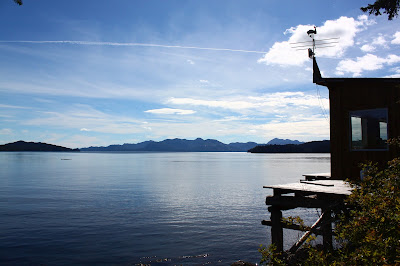Today was an exceptional “holey-moley” day. One of those
days that diminishes any “holey moley” day I’ve had in the past to a “wow”.
The morning started slow with lots of coffee, chatter and
mammal-free scans. We heard talk on the radio of 2 humpbacks near Prince
Royal Island. Janie, who I suspect was feeling a little land-locked having not
been on the ocean in a few days, decided to head out in the research vessel
Elemiah to get ID shots of the pair. I was lucky enough to be next in line for
a boat excursion and willingly climbed aboard.
Heading out of Taylor Bight I let my excitement grow. Would we find them and get up really close?
Maybe we would see them breach? Would we get ID shots and head straight home,
or get to follow them for an hour or so? After a week with only a few glimpses of
distant blows, I would have been happy with anything.
As we neared Prince Royal Island, Neekas (Hermann’s dog
who seems to communicate with whales on some deeper level) became more
attentive and I took this as a sign to scan the horizon. I followed her gaze
and sure enough within seconds I’d spotted their blows. As we approached the
pair of humpbacks they fluked. Like a walking DFO catalog, Janie immediately
knew it was Saucer and Herk. We edged the boat forward, and silently waiting
with camera in hand I tried to anticipate where they would surface.

About 30m away I spotted a few bubbles bursting on the
surface. I whipped the camera up to my face and through the eye piece I saw a
bubble ring form. Before I had time to register what this meant, two great
masses tore through the surface. Mouths wide open and pectoral fins flailing
about in a graceful mess of flesh and baleen, the humpbacks gulped back fish
and water. Within seconds of surfacing, they very slowly and very casually
swam on. I was in shock.” Holey-moley” was all that would register. Did I
really just witness bubble-net feeding? That was on my bucket list, but
something I never thought I would be lucky enough to see.
I thought Humpbacks only used cooperative bubble net feeding
when in large groups, but evidently two is sufficient. The whales dive deep and
move below a school of fish or invertebrates. One whale begins to swim in a
circle underneath the school, blowing bubbles as they move. The bubble ring
effectively corrals and traps the fish which the whales consume as they swim to
the surface with their mouth open.
We followed the whales at a close but safe distance and after a few
moments the pair fluked once again. This time we were prepared. Janie quickly shut off the engine and threw a
hydrophone overboard. The sound of the underwater world filled the boat as I
scanned the surface for telltale signs of the next display. We heard small
popping sounds, almost like throwing tiny pebbles into a stream, and sure
enough bubbles began to burst only 15 metres away. Again the Humpbacks broke
the glassy surface with little effort, so gentle and smooth. They closed their
mouths capturing their prey and crashed together so softly, all part of the
plan. This time I had the camera ready and caught the sequence in stills.

They swam along the shore a short distance, two tiny humans
and two excited dogs hot on their tail, and fluked one after the other.
Hydrophone overboard and eyes peeled, we waited. This time we were lucky enough
to hear them communicate in a soft, drawn out tone. All I could think was
“holey moley, is this actually happening?” as the bubbles surfaced and mouths
emerged. They were about 10 metres away this time, and with this proximity a new
sense kicked in – my sense of smell. I was reminded of the sulphur smell that
fills Rotorua. At first I thought maybe it was Cohen - Janie’s excitable 2 year
old golden retriever. But no, it turns out whales have bad breath. Really bad
breath. Janie said when humpbacks are feeding their breath usually has a fishy
smell to it, but when they first arrive and they’re bodies are still burning
fat their breath can have a sulphur tang to it. Herk hadn’t been sighted yet
this year so may have to take the blame.

We stayed with these whales for a few hours, watching and
listening as they continued to feed only metres from shore. Occasionally we
would move into the footprint to collect prey samples, then excitedly watch the
continued displays while transferring scales into vials of ethanol. Such a
successful trip – ID shots, vocal recordings, prey samples and a very happy
intern.
The whales were aware of our presence but it didn’t seem to
make a difference to them, even when Cohan growled his bear growl and barked excitedly.
I said my thanks to Saucer and Herk and reluctantly turned to head back to the
lab. I am still in shock, not quite believing what I saw. Looking over the
photos I felt as though someone else had taken them. Today seems to be the day
the humpbacks have chosen to arrive, so hopefully there is a lot more to come.
I love this place.















